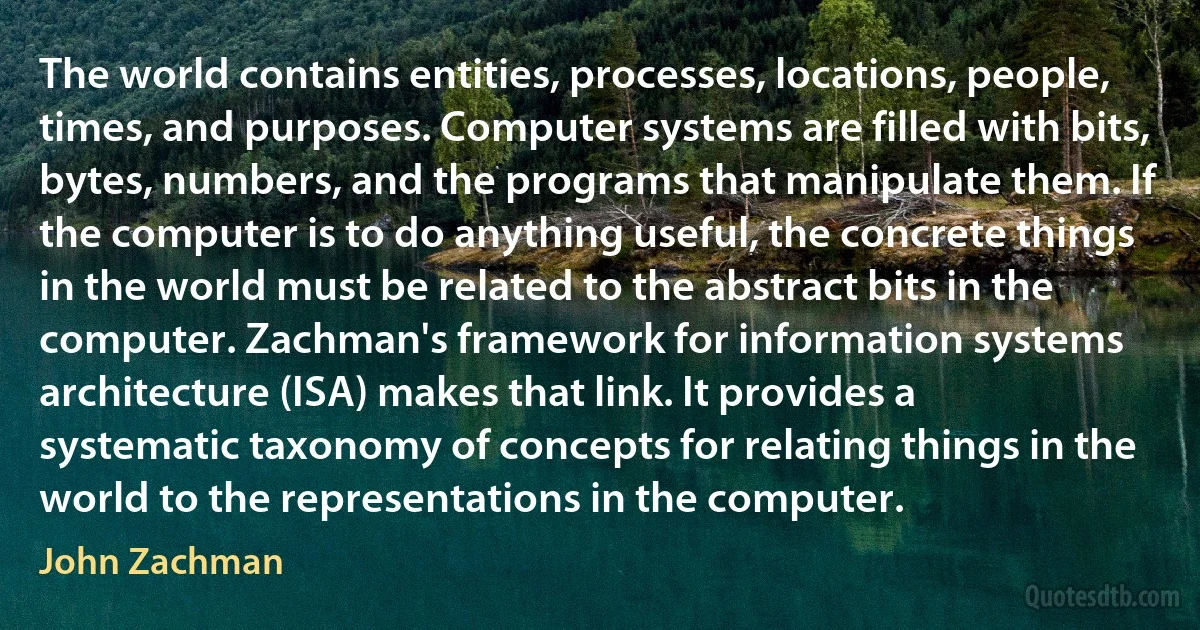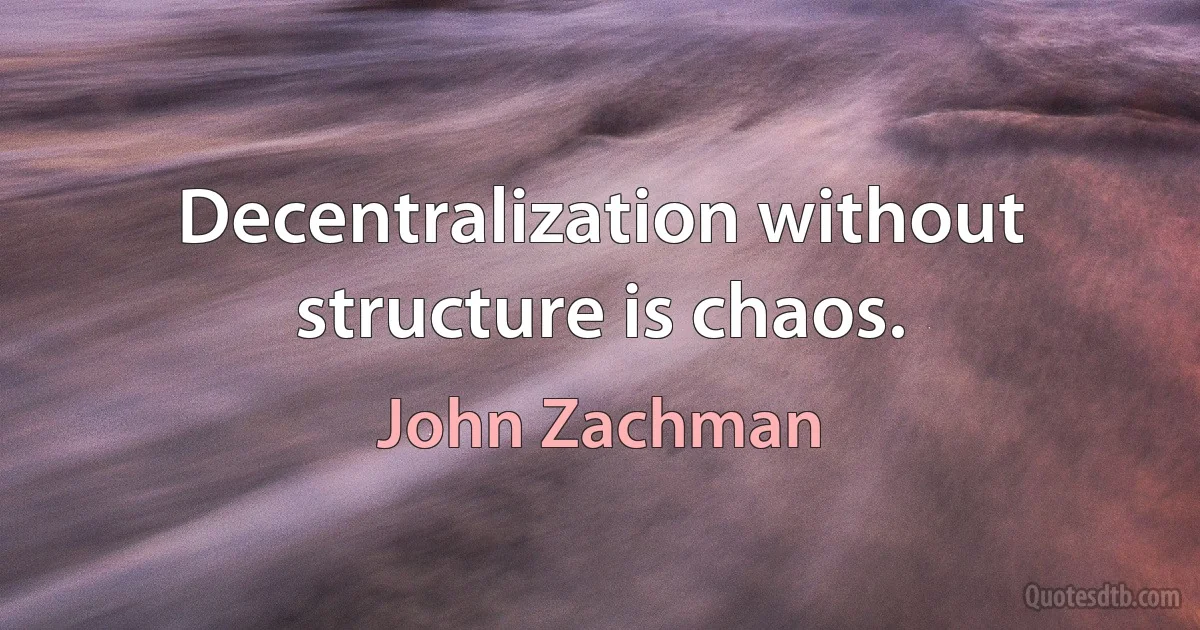John Zachman quotes
Issues of quality, timeliness and change are the conditions that are forcing us to face up to the issues of enterprise architecture. The precedent of all the older disciplines known today establishes the concept of architecture as central to the ability to produce quality and timely results and to manage change in complex products. Architecture is the cornerstone for containing enterprise frustration and leveraging technology innovations to fulfill the expectations of a viable and dynamic Information Age enterprise.

John Zachman
It is only the advent of an automated model storage facility or repository that brings any of this into the realm of feasibility and makes architecture a reality. It does not mean to suggest that all of these ideas will be immediately available in any particular repository product. It only means that they come into the realm of feasibility as repository technology becomes a reality.

John Zachman
The Information Age is unfolding just as predicted by many of the sociological prognosticators of this century. Information issues are on everyone's mind and on multitudes of lips. It is hard to pick up a newspaper or current affairs magazine without seeing a feature on the internet, web pages, e-mail, television terminals or some other new technology. In fact, technology innovation is relentless and escalating and technology stocks continually drive the stock market to high after high. There is no field of human endeavor that is exempt from the onslaught of information technology.

John Zachman
Business System Planning (BSP) and Business Information Control Study (BICS) are two information system planning study methodologies that specifically employ enterprise analysis techniques in the course of their analysis. Underlying the BSP and BICS analysis are the data management problems that result from systems design approaches that optimize the management of technology at the expense of managing the data.

John Zachman
A significant observation regarding... architectural representations is that each is of a different nature than the others. They are not merely a set of representations, each of which is an increasing level of detail than the previous one. Level of detail is an independent variable, varying within each architectural representation.

John Zachman
Although many popular information systems planning methodologies, design approaches, and various tools and techniques do not preclude or are not inconsistent with enterprise-level analysis, few of them explicitly address or attempt to define enterprise architectures. Some examples of such popular offerings include.

John Zachman
A framework as it applies to enterprises is simply a logical structure for classifying and organising the descriptive representations of an enterprise that are significant to the management of the enterprise as well as to the development of the enterprise's system [with the aim of] rationalising the carious concepts and specifications in order to provide for clarity of professional communication, to allow for improving and integrating development methodologies and tools, and to establish credibility and confidence in the investment of systems resources.

John Zachman
In the early ‘80's, there was little interest in the idea of Enterprise Reengineering or Enterprise Modeling and the use of formalisms and models was generally limited to some aspects of application development within the Information Systems community. The subject of "architecture" was acknowledged at that time, however, there was little definition to support the concept. This lack of definition precipitated the initial investigation that ultimately resulted in the "Framework for Information Systems Architecture." Although from the outset, it was clear that it should have been referred to as a "Framework for Enterprise Architecture," that enlarged perspective could only now begin to be generally understood as a result of the relatively recent and increased, worldwide focus on Enterprise "engineering."

John Zachman
The older disciplines of Architecture and Manufacturing have accumulated considerable bodies of product knowledge through disciplined management of the "product definition" design artifacts. This has enabled enormous increases in product sophistication and the ability to manage high rates of product change over time. Similarly, disciplined production and management of "Enterprise definition" (i.e. the set of models identified in the Framework for Enterprise Architecture) should provide for an accumulation of a body of Enterprise knowledge to facilitate enormous increases in Enterprise sophistication and accommodation of high rates of Enterprise change over time.

John Zachman
I came from the information strategy community in the early days and even by the late 1960's, we were quite competent to do information strategy. Although the strategy tools and the methods have improved substantially, the analytical process was quite good understood decades ago. Our problem was, we were have grave difficulties getting from strategy... to implementation.

John Zachman


![[In Mr. Zachman's view] the architect's drawings [represent] a transcription of the owner's perceptual requirements. (John Zachman)](https://cdn.quotesdtb.com/img/quotes_images_webp/98/john-zachman-transcription-view-870698.webp)
